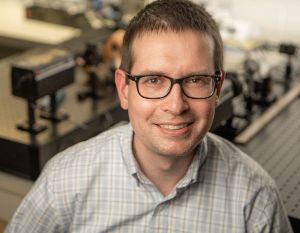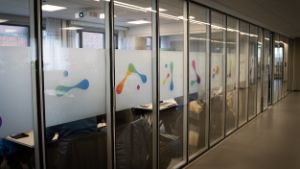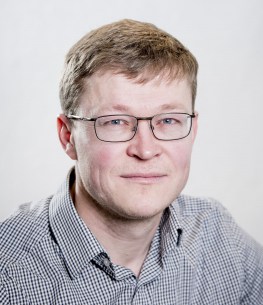Tidligere arrangementer - Side 4
The physics laboratory is a complex environment where students encounter the messiness of the real world, use scientific equipment, execute experimental procedures, make predictions using mathematical and computational models, and more. Despite their potential value, the lab experience can be negative or not effective, especially if the goals and outcomes are not well aligned.
This presentation uses Activity Theory (AT) to make sense of three very different laboratory environments: the “traditional lab”, RealTime Physics (a focus on conceptual learning), and Thinking Critically in Physics Labs (a focus on scientific abilities).
The presentation may be interesting to anyone who is developing or studying laboratory instruction in the sciences.
Predicting static friction in a molecular dynamic system using machine learning
Physicists, computer scientists and mathematicians are increasingly joining the life sciences using their tools to help figuring out how life works.
Brain science is particularly attractive since we have a fairly good understanding of the principles for how individual nerve cells work and how they can be modelled. Now the challenge is to leverage this knowledge to help us understand how networks of thousands, millions and eventually billions of such nerve cells make us perceive, think and feel. In the seminar I will introduce the challenges, and in particular talk about how hundreds of European scientists in the EU Human Brain Project work together to address this formidable and exciting challenge which some call the "holy grail" of neuroscience.
Bayesian neural network estimation of next-to-leading order cross sections
The time-honored conventional lecture (“teaching by telling”) has been shown to be an ineffective mode of instruction for science classes. To enhance critical thinking skills and develop problem-solving abilities, collaborative group-learning environments have proven to be far more effective.
A machine learning approach to understanding depression and anxiety in new mothers
Towards predicting Harmful Conspiracies through Phase Transitions in Complex Interaction Networks
Applications of the Yang-Mills gradient flow to topological observables in QCD
Solving the Many-Electron Problem Using Neural Networks and Variational Monte Carlo
Characterization of Cardiac Cellular Dynamics Using Physics-informed Neural Networks
Plenary lecture 4: Elizabeth Gire, Oregon State University
26 years ago, the physics faculty at Oregon State University radically redesigned their physics majors into the Paradigms in Physics program. Since then, the Paradigms has grown into a user facility for physics education research and curriculum development.
In 2016, we embarked on Paradigms 2.0, a substantial revision to the original Paradigms courses. I will describe the features of our program, what we’ve learned about apprenticing new physicists, and future directions.
Plenary lecture 3: Heather Lewandowski, University of Colorado Boulder
Physics is an empirical science. Therefore, learning physics must include learning how to design and conduct experiments, analyze and interpret data, and revise models and apparatus.
Lab courses are a way for students to engage in these authentic physics practices. Our work looks to improve lab experiences by improving students’ competency with modeling of physical and measurement systems, troubleshooting skills, documentation practices, and views of the nature of experimental physics.
Plenary lecture 2: Brean Prefontaine, Michigan State University
In this introduction to informal physics education (IPER), we will explore the historical and current landscape of research looking at informal physics education spaces and public engagement in physics. We will talk about the different kinds of questions that researchers have and are currently exploring, including the kinds of questions that we are currently researching at Michigan State University.
Just like in other areas of PER, there are a variety of methods that people are using to explore these spaces. We will discuss what kinds of data are being collected within informal spaces and what methods can be used to explore that data. Additionally, in many instances within informal spaces, the researcher and practitioner role are intimately connected.
We will discuss these instances and the importance of researchers disseminated information in a usable manner to practitioners. Finally, we will discuss ways that informal physics spaces are evaluated both internally and externally. Throughout this overview of informal physics education research, I will share examples from my own graduate research and work as an external evaluator.
Anders Malthe-Sørenssen and Tor Ole Odden, University of Oslo
Computation is a cornerstone of modern scientific research, and consequently many universities are actively working to incorporate computational methods into their science courses.
At the University of Oslo, this work has been going since the early 2000s and currently all bachelor programs in mathematics and natural science integrate computing from day one.
For example, in the physics bachelor program, students learn computation in through coordinated mathematics, physics and, computer science courses, and computation is then threaded through most subsequent physics courses.
In this talk, we address the Norwegian educational context, challenges and experiences from establishing such a program, examples of how the program is implemented, and how we work to integrate computing in programs across contexts and across educational levels.
We will also discuss what we are learning through our research activities on how students build computational literacy, and how computation can support student conceptual understanding and epistemic agency.
We would like to invite members of the physics education research groups of Michigan State University, University of Colorado-Boulder, and Oregon State University, as well as our Scandinavian PER colleagues, to a summer institute held in Oslo, Norway, and hosted by the Center for Computing in Science Education at the University of Oslo.
Do you want to learn how to partner with students to bring active learning methods into your teaching? Join us for the Nordic Regional Learning Assistant (LA) Workshop!
In this talk I report on my experiences in teaching programming for humanities students. I have taught this in a variety of ways, as a course for PhD and MA students in linguistics specifically, as a BA-level course in the honours program and as a general BA course for humanities students. The two latter courses were developed in collaboration with CCSE. I will try to say something about why programming is difficult for humanitites students, how it can be made easier and more relevant, and what worked and didn't work in our latest incarnation of the course.
Our world is increasingly computational. In the fields of science, mathematics, engineering, and technology the effects of this shift are well established and ongoing. But what does this mean for other fields, like the arts, humanities, the trades, or agriculture? I will kick off this session by presenting a few ideas and observations on the importance of expanding our notion of computational literacy outside of purely scientific and technical fields, based on my experiences growing up in a farming community and my family network of farmers. Then, we will shift gears to a discussion of what this lens of computational literacy might mean for a general pre-college education and how we can provide a computational education to students outside of traditionally technical fields.
Programming is a useful tool in several disciplines, but teaching programming in a disciplinary context can be quite different than teaching programming for computer scientists. How can we motivate students with different backgrounds to make sure that programming is perceived as relevant? And how does this affect what the students learn? We will talk about how we can teach programming for biologists, chemists, teachers and high school students, and what this teaching implies.
An obvious purpose of computer code is that it gives some desired results when executed on a computer. This is often the overarching focus in programming education, especially outside informatics programs. However, it is in most cases also desirable that code is easily readable and modifiable to humans - this e.g. makes it easier to eradicate bugs or to modify/extend code for new purposes. Many programmers in industry and science are thus arguing for improved programming practices, where the focus is not just on solving one given problem at a time, but on writing code that can be reused and extended to increase productivity in the long run. What is often not explicitly factored into such argumentation, however, is that both learning and applying good programming practices requires effort. This raises two core questions: what level of code quality is typically most pragmatic to aim for in science settings, and how valuable is it to spend course time on learning to improve code quality?
We have encouraged students to develop their own physics problems, explore them and report on their results in the form of a computational essay in the course in elementary electromagnetism (Fys1120) from 2018 to 2021. In parallel we have developed new learning material and supporting exercises to provide students with sufficient skills and knowledge to succeed with an essay project. In 2021 the computational essay project was used as an extended home exam counting 50% towards the final grade.
In this talk, I will discuss experiences and reflections on the use of computational essays and how we plan to develop this activity in the coming years.
Velkommen til det årlige juleseminaret vårt!
Computational thinking (CT) has been added to many educational standards around the world. However, this new content presents challenges around preparing teachers to incorporate computational thinking into the STEM disciplines. In this talk, I will first give a review of the literature around preparing pre-service secondary STEM teachers to incorporate computational thinking into their subjects. I will then present data from interviews with pre-service secondary subject teachers in the STEM teacher education program at UiO . The data highlight a current gap in the research on teacher preparation: that the computation learned in upper division subject courses does not directly translate to the computational thinking that they will be teaching their future students. Finally, I give some suggestions for remedying this gap.
I will present a possible model for task design of mathematical programming problems (MPPs), where both the overarching design and a concrete example is given.
Following the implementation of the design into a mathematics classroom, I will present the students interactions when they were working on MPPs as well as a short analysis of the findings.
Finally, presenting the types of obstacles students encounter when working on MPPs and a discussion regarding the different types. There will be examples from the MPPs, experiences from the implementation, and questions/discussion throughout the module.






